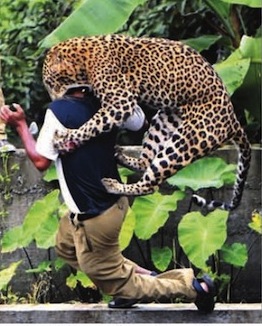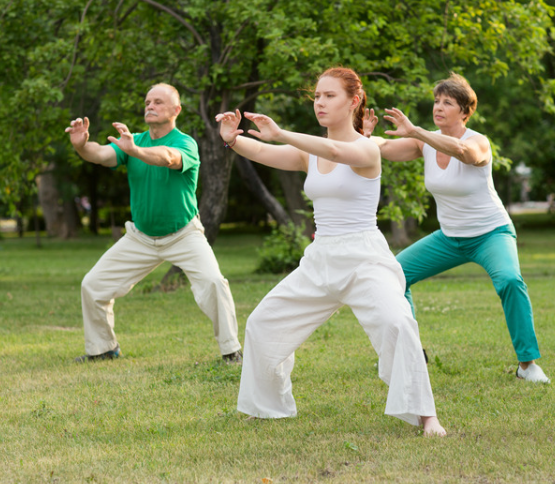Fight like an animal – 8 ways to become stronger, faster and release your animal spirit

Some of the most famous kung fu styles have been based on the movements of animals. The Chinese of old admired the beauty, power, grace and fluidity of various animals and sought to emulate them. They copied their movements and their fighting tactics and created some of the most beautiful and deadly martial arts the world had seen.
To train any of these animal styles successfully requires a basic understanding of the concepts of yin and yang. Some of the animals use lightness, some heaviness, some expansion, some contraction etc.
Training in the animal styles brought to the student the qualities of that animal so that you would become more and more like the animal whose style you were studying. However, some of these styles were never meant to be trained alone but alongside other animals so that each animals strengths would add to the overall development of the student. To over train in one animal style would strengthen some parts and teach certain tactics but would leave other areas vulnerable.
The Shaolin Legend
In the traditional legends of the Shaolin temple it is said that the monks there originally learned exercises from 5 animals – the tiger, monkey, leopard, snake and dragon. These exercises were given to strengthen the bodies of the monks who had been sitting all day in meditation. These 5 animals have lived on in kung fu legend and now many other animals styles are practiced around the world.
In the Jade Dragon tradition we teach 8 animals. These are the original 5 of tiger, monkey, leopard, snake and dragon plus the crane, the mantis and the eagle. The number 8 is a powerful one in Chinese culture as well as in our kung fu system as regular students know – we have 8 ways of holding the body and 8 ways of circling the arms and many variations on those. Within the 8 animal styles we teach each of them will use some, if not all, of those 8 stances and 8 ways of circling the arms.
Below is a breakdown of the benefits that training in each animal style will bring:
Dragon
This system is called Jade Dragon for very good reasons. The dragon is the animal that most represents the principles on which the system is based. The Chinese dragon is associated with water and as such it uses twisting and coiling movements generating force through the whole body and through every movement and angle of attack and defence. The dragon’s movements are circular and it follows the movements of it’s opponent, quickly finds their weaknesses and counter attacks with smooth power. Fighting a dragon is like being sucked into a whirlpool and drowned. It has a wide range of locks, throws, strikes and so on and the coiling footwork and body help the dragon to move in and out of dangerous situations and attack from many angles.
Benefits
- Helps passive people become more powerful and assertive.
- Develops power in every part of the body
- Opens up the joints for increased mobility and qi flow
Snake
The snake is paired with the dragon and also uses coiling movements of waist, legs and upper body. However, where the dragon is yang, the snake is yin, cold and able to penetrate the strongest and most complicated defence. As it has no legs the snake doesn’t use any fixed stances so the footwork is constantly flowing. The snake coils itself around the attacker in many different ways then strikes with extreme speed penetrating muscle, sinew and organ at weak points of the body. At the highest level it is the most instantly lethal of all the animals.
Benefits
- Develops the ability to find the gaps in any defence and strike with precision.
- Teaches focus, balance and patience, waiting for the prey to come within range.
- Helps indecisive people to get around the complexities of a problem and go straight to the most critical matter.
Crane

The crane is a long range animal style especially suited to tall practitioners with long limbs. It uses sweeping movements of the arms to clear a way through attacks and lock or throw an attacker along with striking movements of the beak on vital parts of the body. This is combined with comprehensive kicking patterns as the crane is used to standing on one leg. Studying the crane is a study in angles of attack and defence. It will stand in a studied pose until the prey comes within range then hop out of the way, defend and counter attack from many unusual angles then patiently stand on one leg waiting for the prey to come within range again.
Benefits
- It teaches strength through postural alignments
- Patience, balance and the ability to extend force in many directions.
Tiger
The tiger is paired with the crane but where the crane uses vertical power the tiger uses horizontal power. The tiger is a hugely powerful animal and uses its weight to deliver power that flows through its whole body. It isn’t complicated to learn and uses relatively simple moves that rely on its raw physical strength. It is often one of the first animals we teach as you learn to make every part of the body relaxed and heavy so that you can learn to develop the vitally important whole-body power that is a hallmark of all true kung fu.
Benefits
- Develops physical power
- Develops great rooting power
- Movements aren’t complicated to learn
Eagle
The eagle shares some similarities with the crane but where the crane is a ground fighting bird, the eagle attacks while in flight. The wings are powerful but sensitive enough to detect small changes in air pressure or an attacker’s movements. The eagle’s powerful talons are used to lock or strike the opponent and the general movement of the eagle’s enormously powerful wings keep it covered from attacks from all directions, sweeping them out of the way and opening the opponent to talon and wing strikes. It has one of the best defences of any system. Many of the defensive arm movements taught from the beginning are eagle movements.
Benefits
- Develops power in extended arm movements.
- Has probably the best defensive skills of all the animals
- Develops a heightened sensitivity to your environment and the ability to rise above situations, not be crowded by them but see them from a higher vantage point thus avoid getting bogged down in the details.
Leopard

The leopard is paired with the eagle but where the eagle has a great defence the leopard barely bothers with defence at all.
Among African big game hunters the leopard is considered to be the most dangerous animal (despite the fact that the hippo kills more people). This is because whereas a lion when faced by a group of men will fix its attention on one man and maul only him the leopard will leap from one man to the next killing or severely mauling each in rapid succession. It is also said that the leopard is the only animal, apart from man, that will kill for fun.
The leopard style is one of the best when faced with multiple attackers due to it’s sheer ferocity and speed. It rapidly moves from one man to the next delivering rapid fire strikes and kicks, often not bothering to block but directly hitting the incoming attacks with the famed leopard paw strikes. It is the most ferocious of the animal styles and so is useful in bringing out the ‘killer instinct’ in usually passive people.
Benefits
- Develops speed of attack
- Develops fearlessness and the ability to attack without warning
- Uses a light root so that it can remain quickfooted
- Probably the most effective system for dealing with multiple attackers
Monkey

The monkey is the most agile of animals with arms as strong as its legs. It leaps and rolls then grabs and strikes with amazing rapidity. It is a playful creature that taunts its prey then comes in under an attack and uses short range strikes and throws often rolling over the opponent when he’s on the floor. It uses a lot of low stances and is an expert at bringing an opponent in and taking him down while striking with multiple attacks and kicks.
Benefits
- Physically demanding style to learn
- Develops contractive power,
- Agility and mobility even when crouching down
- Strength in the arms and hands
Mantis
The mantis is paired with the monkey and is a short range system that uses complicated footwork with elbows and finger strikes to hit vital pressure points. The mantis, being an insect, has no higher thoughts and is all instinct and reflex. At close range the system is devastating. The Tang-Lang style which mixes mantis with monkey footwork is reputed to be the only system that defeated the monks of Shaolin.
Benefits
- Speed and patience
- Teaches anatomical knowledge of pressure point targets
- Fast reflexes
Train them all
Training in a variety of animal styles makes you a more rounded person by strengthening your weaknesses and developing your abilities in many different areas. The wide range of movements you will learn will make it so easy to learn other physical skills such as other sports or dance etc. You will develop power and patience, grace and speed, calmness of mind and a will of steel. Four of the eight animals – the dragon, snake, eagle and mantis are used by healers all over the world (although they may not realise it).
The Jade Dragon kung fu system is centred around these 8 animals and the constant interplay of energies and tactics that each one brings. To study one animal is a privilege – to study 8 animals is an opportunity that very few outsiders to the closed world of real Chinese martial arts will ever gain.



